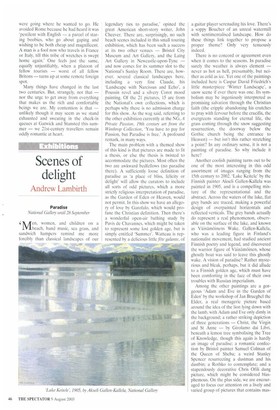Scenes of delight
Andrew Lambirth
Paradise
National Gallery until 28 September
Men, women, and children on a beach, band music, sea grass, and sandwich hampers remind me more forcibly than classical landscapes of our legendary ties to paradise,' opined the great American short-story writer, John Che ever. There are, surprisingly, no such beach scenes included in this small touring exhibition, which has been such a success at its two other venues — Bristol City Museum and Art Gallery, and the Laing Art Gallery in Newcastle-upon-Tyne — and now comes for its summer slot to the National's Sunley Room. There are, however, several classical landscapes here, including a very fine Claude, his 'Landscape with Narcissus and Echo', a Poussin revel and a silvery Corot mood painting. Of the 21 pictures, 15 are from the National's own collections, which is perhaps why there is no admission charge for this show. As the wag said, referring to the other exhibition currently at the NG, A Private Passion, 19th century art from the Winthrop Collection, 'You have to pay for Passion, but Paradise is free.' A profound remark, in many ways.
The main problem with a themed show of this kind is that pictures are made to fit a thesis, or else the thesis is twisted to accommodate the pictures. Most often the two are awkward bedfellows (no paradise there). A sufficiently loose definition of paradise as 'a place of bliss, felicity or delight' will allow the curators to include all sorts of odd pictures, which a more strictly religious interpretation of paradise, as the Garden of Eden or Heaven, would not permit. In this show we have an allegory of love by Garofalo, which would profane the Christian definition. Then there's a wonderful open-air bathing study by Puvis de Chavannes. which might be taken to represent some lost golden age, but is simply entitled 'Summer'. Watteau is represented hv a delicious little .fiW ,wlante. of
a guitar player serenading his love. There's a soppy Boucher of an unreal waterm ill with sentimentalised landscape. How do these things link together to propose a proper theme? Only very tenuously indeed.
There is no concord or agreement even when it comes to the seasons. In paradise surely the weather is always clement — never as hot as hell, presumably, but neither as cold as ice. Yet one of the paintings included here is Caspar David Friedrich's little masterpiece 'Winter Landscape', a snow scene if ever there was one. Its symbolism may be ingeniously interpreted as promising salvation through the Christian faith (the cripple abandoning his crutches to pray with fervour before the crucifix, the evergreens standing for eternal life, the grass coming through the snow suggesting resurrection, the doorway below the Gothic church being the entrance to Heaven) — but isn't this rather stretching a point? In any ordinary sense, it is not a painting of paradise. So why include it here?
Another coolish painting turns out to be one of the most interesting in this odd assortment of images ranging from the 15th century to 2002. 'Lake Keitele' by the Finnish painter Akseli Gallen-Kallela was painted in 1905, and is a compelling mixture of the representational and the abstract. Across the waters of the lake, flat grey bands are traced, making a powerful design of overpainted horizontals and reflected verticals. The grey bands actually do represent a real phenomenon, observable on the surface of the lake, and known as VMnamoinens Wake. Gallen-Kallela, who was a leading figure in Finland's nationalist movement, had studied ancient Finnish poetry and legend, and discovered the warrior figure of VainamOinen, whose ghostly boat was said to leave this ghostly wake. A vision of paradise? Rather mysterious and bleak, perhaps, but it did allude to a Finnish golden age, which must have been comforting in the face of their own troubles with Russian imperialism.
Among the other paintings are a gorgeous 'Adam and Eve in the Garden of Eden' by the workshop of Jan Brueghel the Elder, a real menagerie picture based around the idea of the lion lying down with the lamb, with Adam and Eve only dimly in the background; a rather striking depiction of three generations — Christ, the Virgin and St Anne — by Girolamo dai Libri, beneath a lemon tree symbolising the Tree of Knowledge, though this again is hardly an image of paradise; a romantic confection by Bristol painter Samuel Colman of the Queen of Sheba; a weird Stanley Spencer resurrecting a dustman and his dustbin; a Rothko to contemplate; and a stupendously decorative Chris Ofili dung picture, which might be considered blasphemous. On the plus side, we are encouraged to focus our attention on a lively and varied group of pictures that contains mas


































































 Previous page
Previous page